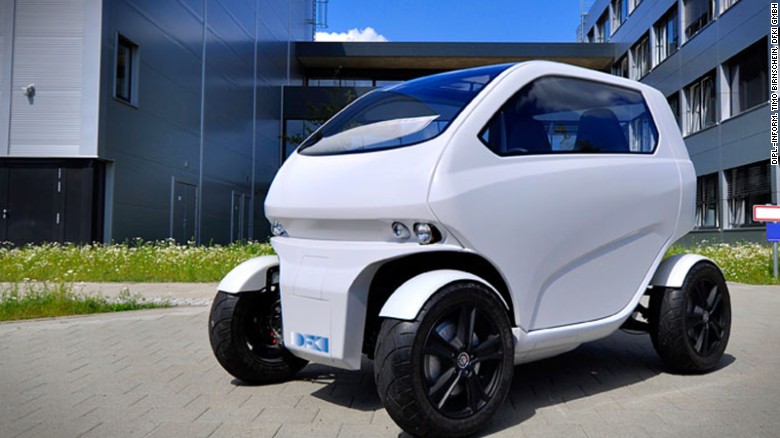导读:上班堵车怎么办?来自德国不来梅的工程师们给出了一种答案:他们研发出一种智能电动汽车,即将改变未来的城市交通!

(CNN) As cities continue to grow at a dizzying rate, commuters are constantly battling ever-increasing congestion on the roads and a lack of parking, just to get to work.
CNN报道——随着城市正以惊人的速度增长,通勤党们也越来越苦于上班路上的堵车以及停车位不足。
But now a team of German engineers have come up with an ingenious solution -- a "flexible" electric vehicle capable of shrinking, driving sideways (think like a crab) and turning on a dime.
但是现在一个德国工程师团队想出了巧妙的解决办法——一种“灵活的”电子车。它能够伸缩,能够横着开(就像螃蟹那样),还能够在极小的空间中转弯。
The EO Smart Connecting Car 2 is an innovative design from DFKI Robotics Innovation Center, based in Bremen, Germany, where a team of software developers and designers, as well as electronics and construction engineers, have been refining the smart micro car project for the last three years.
这款EO Smart Connecting 2电动车来自德国不来梅机器人技术创新中心,开发团队由软件开发者、设计师、电子和结构工程师组成,他们最近三年都在改进这款智能微型车。
First announced in 2012, the team have moved onto their second iteration of the vehicle. It drives like a traditional car but because each wheel is powered by its own motor, it also has the capability of driving sideways, allowing it to slide into tight spaces in urban areas where parking is limited, explains Timo Birnschein, project manager for the vehicle.
这款车首次发布于2012年,之后团队发布了它的最新版本。项目经理提莫·比尔施海因解释说,平时它像传统的车那样行驶,但是因为四个轮子是由自有马达驱动的,所以它具有横向行驶的功能,这样就能在城市停车空间有限的情况下滑进停车位。
He adds: "The whole process -- the transition between normal driving and driving sideways -- takes about four seconds."
他补充说:“整个过程——从普通行驶模式到横向行驶模式——只需要四秒钟。”
The prototype has a top speed of 65 km/h (or 40mph) and can travel 50 to 70 kilometers (30 to 44 miles) on a single four-hour full charge of the battery. But it’s the two-seater’s ability to shrink to around 1.5 meters in length that has the team excited about its uses in future cities, says Birnschien.
这款车最高时速为65千米,单块电池在充满电的情况下可以坚持四个小时,行驶50-70公里。比尔施海因说,这款两座车可以缩小到1.5米左右,团队对其在未来城市的用途很是津津乐道。
"It is able to reduce its own size by about 80cm, which makes it almost as small as a bike in length. And with this kind of feature you can go into very tiny parking spaces," he says. "You are still able to turn on the spot, you are still able to drive sideways and you are still able to connect to charging stations, for example."
“它能够将自身的大小缩小80厘米,这样就跟一架自行车一样长了。这个功能可以让你开进很小的停车位里。”他说,“比如,你还可以当场转弯、横向行驶以及将车连接到充电站。”
Looking like part "Transformer" and part DeLorean out of "Back to the Future," the car reduces its size by partly folding itself. It shifts the rear axle to the front and slides on a set of rails which raises the interior upwards, while still remaining comfortable for the passenger.
这款车有点像“变形金刚”,还有点像“德罗宁跑车”。它减少大小的方式是将自身的一部分折叠起来——它将后轴沿着一套轨道向前推,将车的内部抬高,不会给乘客造成不适感。
Touted as a "micro car for a megacity," the team are working hard to make their vehicle roadworthy and envision it as a communal public resource, similar to existing urban car-sharing schemes. The idea is that when you need a car, you could head to your nearest docking station and select the vehicle that’s charged enough to drive the distance you need. It would then detach itself and you would be on your way.
这款车一直作为“超大城市里的超小车”宣传,团队的努力工作使其更加适宜在道路上使用,并将其展望成一种公共资源,和现在城市里的车辆共享计划类似。这个计划就是如果你想用车,就去最近的泊车站选一辆充电量足够行驶你需要里程的车。届时这辆车将自动脱离泊车站,你就可以上路了。
"[It] is very comparable feature-wise to the first prototype," says Birnschein. "The second version is much more reliable and almost road-legal. It’s not really, but it’s almost there and we are trying to bring this car to the road -- but it’s a big hassle to be honest because we have so many new technologies in the car that the technical advisory guys are skeptical."
“这比第一代车的特性智能得多。”比尔施海因说,“第二代车更加安全可靠,也几乎符合道路法。我们还没争取到这款车的路权——不过也快了。但是说实话,这里有一个巨大的障碍——我们在这款车里应用了太多新技术,那些技术顾问表示很怀疑。”
He adds that the team have invited several manufacturers to test drive the vehicle, with positive response, but the enthusiasm ends there.
他补充说,团队已经邀请了几家制造商试驾这款车,回应是很热情,但是热情仅止于此了。
"The problem is for most car manufacturers, they are not really interested if they didn’t invent it themselves. They may buy from Bosch or Siemens or whatever, technology parts like ESP and other things, but not complete systems."
“问题是,对大多数制造商来说,如果不是他们自己开发的车,他们就不是真正的感兴趣。他们可能会向博世或者西门子采购电子稳定装置之类的技术零件,但是不会采购整个系统。”
But his team remains undeterred as they continue working on autonomous features like auto pilot and self-parking. Meanwhile Birnschein likens the situation to the rise in smartphones over the last decade -- from non-existence to oversaturation.
但是他的团队依然不屈不挠,继续研究自动导航、自动停车等特性。同时比尔施海因还将现状比作近十年内智能手机的崛起——从不存在到无处不在。
"It will be the same with computer power and autonomy," he says. "In the next 10 years we will most likely see autonomous cars from big car manufacturers -- Mercedes S class will have autonomous functions within three or four years. Some of other manufacturers like GM announced they will have semi-autonomous cars by 2020. And many other car manufacturers are already working on this type of technology.
“电脑技术和自动化技术也是一样。”他说,“在未来的十年里,我们很有可能看到大汽车制造商的自动汽车——梅赛德斯奔驰S系列将在三四年内拥有自动化功能。像通用电气这样的制造商也宣布他们将在2020年之前开发出半自动汽车。还有很多汽车制造商已经在开发这类技术了。
"They are driving all the time on the autobahn with autonomous vehicles. I believe it will be coming -- it will be there within the next decade."
“将来高速公路上将会全都是自动汽车。我相信那一天一定会到来的——就在这十年里。”







